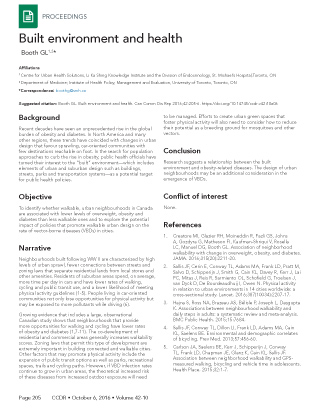Archived - Built environment and health

 Download this article as a PDF (369 KB - 2 pages)
Download this article as a PDF (369 KB - 2 pages) Published by: The Public Health Agency of Canada
Issue: Volume 42-10: Emerging challenges of vector-borne diseases and cities
Date published: October 6, 2016
ISSN: 1481-8531
Submit a manuscript
About CCDR
Browse
Volume 42-10, October 6, 2016: Emerging challenges of vector-borne diseases and cities
Proceedings
Built environment and health
Booth GL1,2*
Affiliations
1 Centre for Urban Health Solutions, Li Ka Shing Knowledge Institute and the Division of Endocrinology, St. Michael's Hospital, Toronto, ON
2 Department of Medicine; Institute of Health Policy, Management and Evaluation, University of Toronto, Toronto, ON
Correspondence
Suggested citation
Booth GL. Built environment and health. Can Comm Dis Rep 2016;42:205-6. https://doi.org/10.14745/ccdr.v42i10a06
Background
Recent decades have seen an unprecedented rise in the global burden of obesity and diabetes. In North America and many other regions, these trends have coincided with changes in urban design that favour sprawling, car-oriented communities with few destinations reachable on foot. In the search for population approaches to curb the rise in obesity, public health officials have turned their interest to the "built" environment—which includes elements of urban and suburban design such as buildings, streets, parks and transportation systems—as a potential target for public health policies.
Objective
To identify whether walkable, urban neighbourhoods in Canada are associated with lower levels of overweight, obesity and diabetes than less walkable ones and to explore the potential impact of policies that promote walkable urban design on the rate of vector-borne diseases (VBDs) in cities.
Narrative
Neighbourhoods built following WW II are characterized by high levels of urban sprawl, fewer connections between streets and zoning laws that separate residential lands from local stores and other amenities. Residents of suburban areas spend, on average, more time per day in cars and have lower rates of walking, cycling and public transit use, and a lower likelihood of meeting physical activity guidelinesFootnote 1Footnote 2Footnote 3Footnote 4Footnote 5. People living in car-oriented communities not only lose opportunities for physical activity but may be exposed to more pollutants while drivingFootnote 6.
Growing evidence that includes a large, observational Canadian study shows that neighbourhoods that provide more opportunities for walking and cycling have lower rates of obesity and diabetesFootnote 1Footnote 7Footnote 8Footnote 9Footnote 10Footnote 11. The co-development of residential and commercial areas generally increases walkability scores. Zoning laws that permit this type of development are extremely important in building connected and walkable cities. Other factors that may promote physical activity include the expansion of public transit options as well as parks, recreational spaces, trails and cycling paths. However, if VBD infection rates continue to grow in urban areas, the theoretical increased risk of these diseases from increased outdoor exposure will need to be managed. Efforts to create urban green spaces that foster physical activity will also need to consider how to reduce their potential as a breeding ground for mosquitoes and other vectors.
Conclusion
Research suggests a relationship between the built environment and obesity-related diseases. The design of urban neighbourhoods may be an additional consideration in the emergence of VBDs.
Conflict of interest
None.